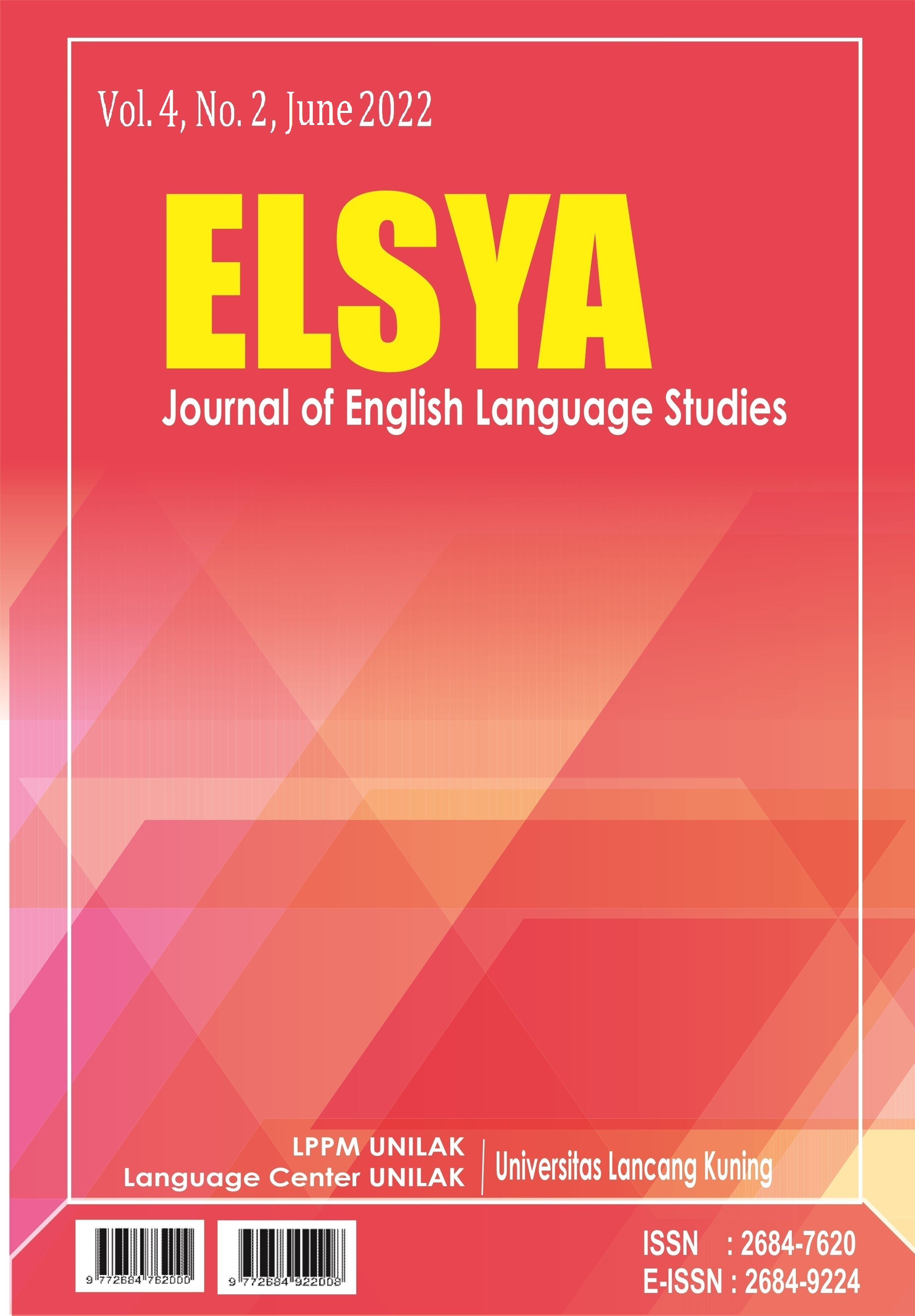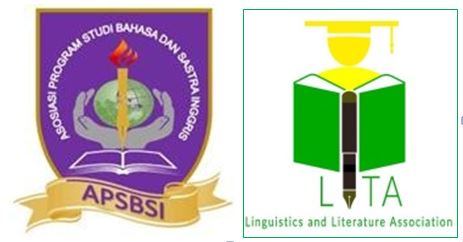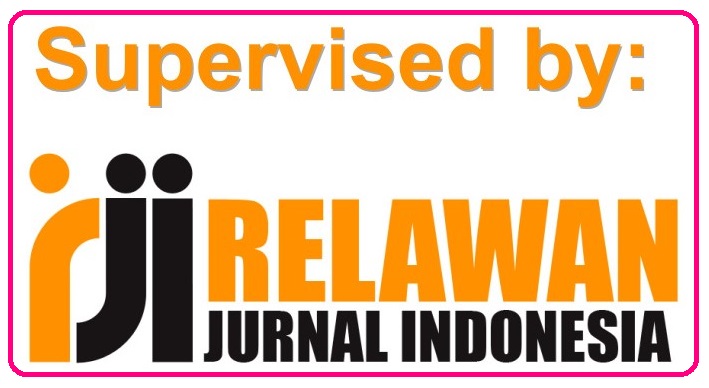Interlingual Errors in Indonesian EFL learners' Pronunciation: From Minimal Pairs to Speaking Ability
Abstract
The majority of previous research observed phonemes produced individually to examine errors. As a result, based on the concept of minimum pairings, this study offered a novel way of assessing interlingual errors based on the concept of minimal pairings. This study examines the interlingual errors in consonant minimal pairs to see the correlation between the errors and the speaking ability that happened to high school students. There are several consonants which are being used such as /v/, /θ̠/, /ð̠/, /ʃ/, /t̠ʃ/, /ʤ/, /f/, /t/, /d/, /z/, and /s/ as indicators to find the interlingual errors. This study is descriptive qualitative research that examines the interlingual errors produced by high school students when utilizing English minimal pairs of consonants. All of the consonants acted as the test tool for the 19 selected students in the form of 10 minimal pairs. The research found that students did have difficulties when they were pronouncing the consonant minimal pairs such as /d/ & /ð/, /f/ & /v/, and /ʃ/ & /t̠ʃ/. Thus, the difficulties that occurred in the students’ pronunciation also generate speaking ability between students based on the interlingual errors. The findings showed that high school students mostly struggled with their pronunciation when uttering consonants that do not exist in the Indonesian language. In conclusion, interlingual errors play an important role as a method in teaching a foreign language to see the consonant errors happen in high school students when pronouncing the English language.
Downloads
References
Ambalegin, A., & Arianto, T. (2018). ENGLISH VOWELS AND CONSONANTS MISPRONUNCIATION OF THE SEVENTH PRESIDENT OF REPUBLIC OF INDONESIA IN HIS OFFICIAL ENGLISH SPEECHES AND ITS INFLUENCING FACTORS. Language Literacy: Journal of Linguistics, Literature, and Language Teaching, 2(2), 113–128. https://doi.org/10.30743/ll.v2i2.678
Andi-Pallawa, B., & Alam, A. F. A. (2013). A Comparative Analysis between English and Indonesian Phonological Systems. International Journal of English Language Education, 1(3), 103–129. https://doi.org/10.5296/ijele.v1i3.3892
Bengtsson, M. (2016). How to plan and perform a qualitative study using content analysis. NursingPlus Open, 2, 8–14. https://doi.org/10.1016/j.npls.2016.01.001
Bui, T. S. (2016). PRONUNCIATION OF CONSONANTS /ð/ AND /θ/ BY ADULT VIETNAMESE EFL LEARNERS. Indonesian Journal of Applied Linguistics, 6(1), 125. https://doi.org/10.17509/ijal.v6i1.2744
Bunce, P. (2020). Phonemic Awareness: A Core Phonological Skill in Learning English. JALT Postconference Publication, 2019(1), 314. https://doi.org/10.37546/JALTPCP2019-37
Cao, R., & Jin, S. (2018). Phonological Differences between Received Pronunciation and Standard Scottish English. Proceedings of the 2017 International Seminar on Social Science and Humanities Research (SSHR 2017). 2017 International Seminar on Social Science and Humanities Research (SSHR 2017), Arnoma, Thailand. https://doi.org/10.2991/sshr-17.2018.21
Crystal, D. (2008). A dictionary of linguistics and phonetics (6th ed). Blackwell Pub.
Daud, B., & Salamah, U. (2016). Teaching phonics and phonemic awareness in English Beginning reading. English Education Journal, 7(3), 329–340.
Fadhillah, M. F., & Miftakh, F. (2020). EFL STUDENTS’ PRONUNCIATION ERROR ANALYSIS ON ENGLISH SHORT VOWEL SOUNDS. 1, 9.
Fadillah, A. C. (2020). PRONUNCIATION DIFFICULTIES OF EFL LEARNERS IN INDONESIA: A LITERATURE STUDY. Jurnal Budaya Brawijaya, 2(1), 7–13.
Fauzi, F. (2020). Error Analysis of Sundanese English Pronunciation on Fricatives Sound. Buletin Al-Turas, 20(1), 199–218. https://doi.org/10.15408/bat.v20i1.3756
Firdaus, S. F., Indrayani, L. M., & Soemantri, Y. S. (2020). The Production of Interdental Fricatives by English as a Foreign Language Students in English Course Bandung. Linguistics and ELT Journal, 8(1), 1–9. https://doi.org/10.31764/leltj.v8i1.2546
Fuchs, S., & Birkholz, P. (2019). Phonetics of Consonants. In S. Fuchs & P. Birkholz, Oxford Research Encyclopedia of Linguistics. Oxford University Press. https://doi.org/10.1093/acrefore/9780199384655.013.410
Hasyim, M. (2020). PROBLEMATIC ENGLISH SEGMENTAL SOUNDS: EVIDENCE FROM INDONESIAN LEARNERS OF ENGLISH. Palarch’s Journal Of Archaeology Of Egypt/Egyptology, 17(6), 10. KAHPES-2.
Hu, M. (2019). The Relationship between English Phonological Awareness of Chinese English Learners and Their English Skills. Theory and Practice in Language Studies, 9(1), 45. https://doi.org/10.17507/tpls.0901.07
Huo, S., & Wang, S. (2017). The Effectiveness of Phonological-Based Instruction in English As a Foreign Language Students at Primary School Level: A Research Synthesis. Frontiers in Education, 2, 15. https://doi.org/10.3389/feduc.2017.00015
Irianto, N. A., Imranuddin, & Sabaruddin, S. (2018). AN ANALYSIS OF PRONUNCIATION ERRORS OF ENGLISH CONSONANTS: /?/ And /ð/ BY THE STUDENTS OF THE ENGLISH EDUCATION STUDY PROGRAM OF UNIVERSITY OF BENGKULU. Journal of English Education and Teaching, 2(3), 18–28. https://doi.org/10.33369/jeet.2.3.18-28
Irianto, N. A., Imranuddin, & Syafrizal S. (2018). AN ANALYSISOFPRONUNCIATION ERRORS OF ENGLISH CONSONANTS : /θ/ and /ð/ BY THE STUDENTS OF THE ENGLISH EDUCATION STUDY PROGRAM OF UNIVERSITY OF BENGKULU. Journal of English Education and Teaching, 2(3), 11. https://doi.org/10.32678/loquen.v12i1.1676
James, C. (2013). Errors in language learning and use: Exploring error analysis. Longman.
Khan, M., & Khan, R. (2021). Phonological Awareness and Phonics Instruction: Inclusive practice that benefits all kinds of learners. Asia Pacific Journal of Developmental Differences, 8(1), 173–185. https://doi.org/10.3850/S2345734121000076
Kim, H., Sefcik, J. S., & Bradway, C. (2017). Characteristics of Qualitative Descriptive Studies: A Systematic Review: QUALITATIVE DESCRIPTION: SYSTEMATIC REVIEW. Research in Nursing & Health, 40(1), 23–42. https://doi.org/10.1002/nur.21768
Lestari, D. D., Suryani, F. B., & Nuraeningsih, N. (2020). PRONUNCIATION ERRORS MADE BY EFL STUDENT TEACHERS IN SPEECH PERFORMANCE. Prominent, 3(2). https://doi.org/10.24176/pro.v3i2.5396
Ma’arif, M. S., & Robayanah, S. Q. (2021). KAJIAN FONOLOGI BAHASA INDONESIA DALAM KUMPULAN VIDEO MAK BETI KARYA ARIF MUHAMMAD. 1(01), 20.
Maiza, M. (2020). An Analysis of Students’ Pronunciation Errors. Journal of English Education and Literature, 1(1), 6. https://doi.org/10.38114/joeel.v1i1.27
Martanti, I. F. R. (2022). Pronunciation Errors in Students’ Vlog Projects. Acitya: Journal of Teaching and Education, 4(1), 252–265. https://doi.org/10.30650/ajte.v4i1.3221
Merrita, D. (2021). THE PRODUCTION OF ENGLISH CONSONANTS /θ/ AND /ð/ BY ENGLISH DEPARTMENT STUDENTS. LINGUA : JURNAL ILMIAH, 17(2), 26–44. https://doi.org/10.35962/lingua.v17i2.85
Metruk, R. (2017). Pronunciation of English Dental Fricatives by Slovak University EFL Students. International Journal of English Linguistics, 7(3), 11. https://doi.org/10.5539/ijel.v7n3p11
Mubarok, Y., & Nur’aisyah, A. H. (2020). Native Language Interference in Learning a Second Language. Buletin Al-Turas, 26(1), 173–188. https://doi.org/10.15408/bat.v26i1.13797
Pardede, P. (2018). Improving EFL Students’ English Pronunciation by Using the Explicit Teaching Approach. JET (Journal of English Teaching), 4(3), 143. https://doi.org/10.33541/jet.v4i3.852
Piccardo, E., Goodier, T., & North, B. (2018). Common European Framework of Reference for Languages: Learning, Teaching, Assessment. Companion Volume with New Descriptors. Council of Europe Publishing. www.coe.int/lang-cefr
Plailek, T., & Al, E. (2021). Pronunciation Problems and Factors Affecting English Pronunciation of EFL Students. Turkish Journal of Computer and Mathematics Education (TURCOMAT), 12(12), 2026–2033.
Pourhosein Gilakjani, A., & Sabouri, N. B. (2016). Why Is English Pronunciation Ignored by EFL Teachers in Their Classes? International Journal of English Linguistics, 6(6), 195. https://doi.org/10.5539/ijel.v6n6p195
Pratiwi, D. R., & Indrayani, L. M. (2021). Pronunciation Error on English Diphthongs Made by EFL Students. TEKNOSASTIK, 19(1), 24–30. https://doi.org/10.33365/ts.v19i1.486
Purba, C. N. (2018). The Pronunciation Problems of the English Department Students in the University of HKBP Nommensen. Journal of English Teaching as a Foreign Language, 4(1), 57–67.
Puspandari, A. (2013). Erroneous Production of Apico-Dental Fricative Consonant Sounds by Javenese School Students. Lexicon, 2(2), 85–94. https://doi.org/10.22146/lexicon.v2i2.42179
Putra, F. P. (2019). An Error Analysis of English Plosive and Fricative Consonants at Vocational High Schools. Wanastra : Jurnal Bahasa Dan Sastra, 11(2), 141–150. https://doi.org/10.31294/w.v11i2.6213
Rahman, I. F. (2018). THE USE OF MINIMAL PAIR TECHNIQUE IN TEACHING PRONUNCIATION AT THE SECOND YEAR STUDENTS OF SMAN 4 BANTIMURUNG. ETERNAL (English, Teaching, Learning, and Research Journal), 4(2), 276. https://doi.org/10.24252/Eternal.V42.2018.A11
Ramasari, M. (2017). Students Pronounciation Error Made in Speaking for General Communication. Linguistic, English Education and Art (LEEA) Journal, 1(1), 37–48. https://doi.org/10.31539/leea.v1i1.32
Rokhman, M. F., Lintangsari, A. P., & Perdhani, W. C. (2020). EFL learners’ phonemic awareness: A correlation between English phoneme identification skill toward word processing. JEES (Journal of English Educators Society), 5(2), 135–141. https://doi.org/10.21070/jees.v5i2.467
Romupal, E. L., Rubio, C. M., & Toquero, C. M. (2021). Learning by Doing Intervention: Addressing Phonological Difficulties of Children through Audiolingual Method and Total Physical Response. Elsya : Journal of English Language Studies, 3(3), 150–162. https://doi.org/10.31849/elsya.v3i3.6778
Sari, E. M. P. (2016). INTERLINGUAL ERRORS AND INTRALINGUAL ERRORS FOUND IN NARRATIVE TEXT WRITTEN BY EFL STUDENTS IN LAMPUNG. Jurnal Penelitian Humaniora, 17(2), 87. https://doi.org/10.23917/humaniora.v17i2.2501
Silalahi, R. M. P. (2017). Pronunciation Problems of Indonesian EFL Learners: An Error Analysis. Journal of English Language and Culture, 6(2), Article 2. https://doi.org/10.30813/jelc.v6i2.263
Situmeang, I. T., & Lubis, R. F. (2020). Students’ Difficulties in Pronouncing Fricative Consonant. English Education : English Journal for Teaching and Learning, 8(01), 38–46. https://doi.org/10.24952/ee.v8i01.2676
Sokip, Dr. (2020). Overcoming the Problem of Learning Foreign Language Skills in the Classroom. Universal Journal of Educational Research, 8(2), 723–729. https://doi.org/10.13189/ujer.2020.080246
Trisnawati, I., Mulyani, S., & Syam, A. (2020). Error Analysis on English Consonant Pronunciation Produced By The Fifth Semester Students of English Education Department. TAMADDUN LIFE, 19(2), 14. https://doi.org/10.33096/tamaddun.v19i2.77
Untoro, S., & Rustipa, K. (2020). MISPRONUNCIATION OF ENGLISH FRICATIVES AND AFFRICATES PRODUCED BY ENGLISH STUDENTS OF STIKUBANK UNIVERSITY. Dinamika Bahasa Dan Budaya, 15(2), 9. https://doi.org/10.35315/bb.v15i2.8222
Wafi, A., Ratnawati, R., & Fuqaha’, A. (2020). Error Analysis on Voicing Sounds Uttered by English Department Students at State Islamic Institute of Madura. PANYONARA: Journal of English Education, 2(2), 81. https://doi.org/10.19105/panyonara.v2i2.3412
Yeung, S. S. S., Siegel, L. S., & Chan, C. K. K. (2013). Effects of a phonological awareness program on English reading and spelling among Hong Kong Chinese ESL children. Reading and Writing, 26(5), 681–704. https://doi.org/10.1007/s11145-012-9383-6
Yusriati, Y., & Hasibuan, S. H. (2019). The Analysis of English Pronunciation Errors by English Education Students of FKIP UMSU. Journal of English Education and Teaching, 3(2), 230–248. https://doi.org/10.33369/jeet.3.2.230-248
Zhu, M. (2019). The Important Part of Error Analysis in Second Language Acquisition. 254–258. https://doi.org/10.2991/hsmet-19.2019.45
- Author retains the copyright and grants Elsya Journal the right of first publication of the work simultaneously licensed under the Creative Commons Attribution-ShareAlike 4.0 License that allows others to share the work with an acknowledgment of the work's authorship and initial publication in this journal
- The author is able to enter into separate, additional contractual arrangements for the non-exclusive distribution of the journal's published version of the work (e.g., post it to an institutional repository or publish it in a book) with the acknowledgment of its initial publication in this journal.
- The author is permitted and encouraged to post his/her work online (e.g., in institutional repositories or on their website) prior to and during the submission process, as it can lead to productive exchanges, as well as earlier and greater citation of the published work (See The Effect of Open Access).








 Elsya Journal is licensed under
Elsya Journal is licensed under 